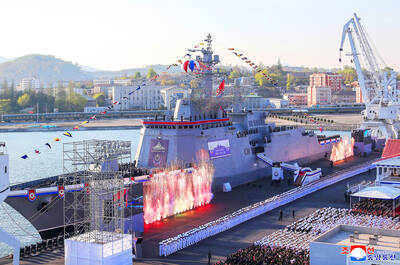The US government will face a complex and delicate task when it moves to unwind the federal financial bailout that officially ends in October, and the rescue will leave a deep impact in the economy long afterward, a report from a government watchdog panel says.
The US$700 billion taxpayer bailout will leave a legacy in financial markets, which may now be convinced the government will rescue financial institutions considered too big to fail, a new report by the Congressional Oversight Panel says.
That expectation gives big banks and other institutions an advantage in raising capital that smaller ones don’t enjoy and encourages a “moral hazard” for the big banks to take risks again, the report released yesterday says.
It says that as a result of the so-called Troubled Asset Relief Program (TARP), the Treasury Department now holds hundreds of billions of dollars of assets — about US$258 billion as of Dec. 31 — that it must eventually sell.
That will require a delicate balance between maximizing the return to taxpayers and maintaining financial stability.
“There are ... unavoidable political considerations that will affect these decisions, and that political context in the current environment can shift quickly and unpredictably,” the report says.
There is also the question of how the banks, other financial firms and automakers that received bailout aid intend to make the taxpayers whole, the panel said.
“In fact, TARP will live on for years,” panel chairwoman Elizabeth Warren said in a call with reporters on Wednesday, noting that Treasury will still have authority to dispense some funds and will be managing the hundreds of billions in assets.
“Treasury must learn from the mistakes it made over the past year,” she said.
In response to the report, Treasury spokeswoman Meg Reilly said the department “has demonstrated a cautious, transparent and disciplined approach in winding down the emergency programs, which is already yielding positive returns for taxpayers and the health of the economy.”
Treasury estimates that TARP programs aimed at stabilizing the banking system will earn a profit thanks to dividends, interest, early repayments and the sale of the government’s stakes in the institutions receiving aid, Reilly said in a statement.
“Taxpayers have already received over US$16 billion in profits from all TARP programs and that profit could be considerably higher as Treasury sells additional [stakes] in the weeks ahead,” she said.
The panel, one of three oversight mechanisms Congress mandated for the bailout that it enacted at the height of the financial crisis in October 2008, makes periodic assessments of how the government is managing the rescue program.
Treasury Secretary Timothy Geithner announced last month that the politically unpopular bailout program, originally slated to expire at the end of last year, would be extended until Oct. 3. The Obama administration says the fund is still needed to prevent further turmoil in the banking system.
The extension set up a struggle between Democrats who favor using some of the leftover TARP money to help generate jobs, and Republicans who say it should be used to shrink soaring budget deficits.
The administration projects that the losses to the government from the bailout will be around US$116 billion — compared with an estimate of US$340 billion in August.
Most of the losses are expected to come from the rescue of General Motors and the bailout of insurance conglomerate American International Group Inc.
The report noted that Treasury has put forward three principles to guide its decisions of when to sell the assets: maintaining the stability of the financial system, preserving the integrity of individual financial institutions, and maximizing return for taxpayers.

Archeologists in Peru on Thursday said they found the 5,000-year-old remains of a noblewoman at the sacred city of Caral, revealing the important role played by women in the oldest center of civilization in the Americas. “What has been discovered corresponds to a woman who apparently had elevated status, an elite woman,” archeologist David Palomino said. The mummy was found in Aspero, a sacred site within the city of Caral that was a garbage dump for more than 30 years until becoming an archeological site in the 1990s. Palomino said the carefully preserved remains, dating to 3,000BC, contained skin, part of the

TRUMP EFFECT: The win capped one of the most dramatic turnarounds in Canadian political history after the Conservatives had led the Liberals by more than 20 points Canadian Prime Minister Mark Carney yesterday pledged to win US President Donald Trump’s trade war after winning Canada’s election and leading his Liberal Party to another term in power. Following a campaign dominated by Trump’s tariffs and annexation threats, Carney promised to chart “a new path forward” in a world “fundamentally changed” by a US that is newly hostile to free trade. “We are over the shock of the American betrayal, but we should never forget the lessons,” said Carney, who led the central banks of Canada and the UK before entering politics earlier this year. “We will win this trade war and

‘BODIES EVERYWHERE’: The incident occurred at a Filipino festival celebrating an anti-colonial leader, with the driver described as a ‘lone suspect’ known to police Canadian police arrested a man on Saturday after a car plowed into a street party in the western Canadian city of Vancouver, killing a number of people. Authorities said the incident happened shortly after 8pm in Vancouver’s Sunset on Fraser neighborhood as members of the Filipino community gathered to celebrate Lapu Lapu Day. The festival, which commemorates a Filipino anti-colonial leader from the 16th century, falls this year on the weekend before Canada’s election. A 30-year-old local man was arrested at the scene, Vancouver police wrote on X. The driver was a “lone suspect” known to police, a police spokesperson told journalists at the

North Korean leader Kim Jong-un has unveiled a new naval destroyer, claiming it as a significant advancement toward his goal of expanding the operational range and preemptive strike capabilities of his nuclear-armed military, state media said yesterday. North Korea’s state-run Korean Central News Agency (KCNA) said Kim attended the launching ceremony for the 5,000-tonne warship on Friday at the western port of Nampo. Kim framed the arms buildup as a response to perceived threats from the US and its allies in Asia, who have been expanding joint military exercises amid rising tensions over the North’s nuclear program. He added that the acquisition